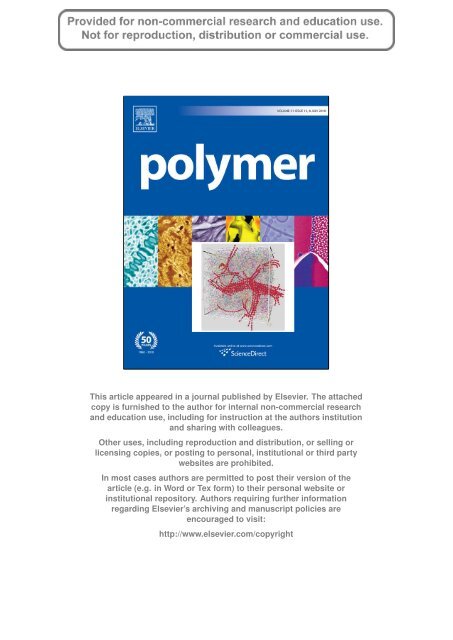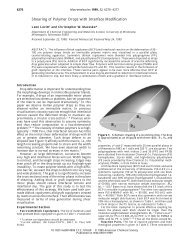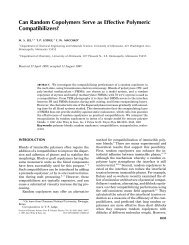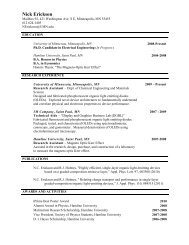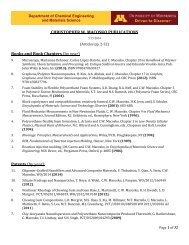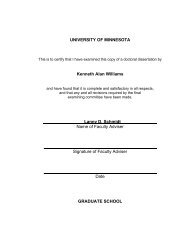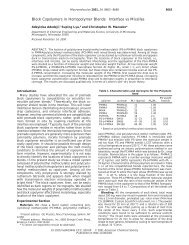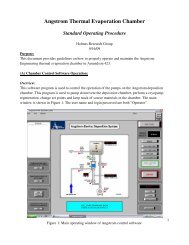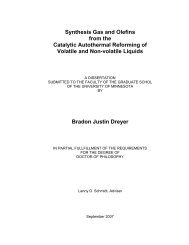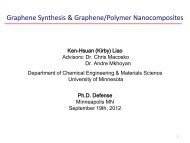Nanodispersions of carbon nanofiber for polyurethane foaming
Nanodispersions of carbon nanofiber for polyurethane foaming
Nanodispersions of carbon nanofiber for polyurethane foaming
Create successful ePaper yourself
Turn your PDF publications into a flip-book with our unique Google optimized e-Paper software.
This article appeared in a journal published by Elsevier. The attachedcopy is furnished to the author <strong>for</strong> internal non-commercial researchand education use, including <strong>for</strong> instruction at the authors institutionand sharing with colleagues.Other uses, including reproduction and distribution, or selling orlicensing copies, or posting to personal, institutional or third partywebsites are prohibited.In most cases authors are permitted to post their version <strong>of</strong> thearticle (e.g. in Word or Tex <strong>for</strong>m) to their personal website orinstitutional repository. Authors requiring further in<strong>for</strong>mationregarding Elsevier’s archiving and manuscript policies areencouraged to visit:http://www.elsevier.com/copyright
Author's personal copyG. Harikrishnan et al. / Polymer 51 (2010) 3349e3353 3351a1000bG (Pa)Polyol-1%CNFMDI-1%CNFG (Pa)1000Polyol-3%CNFMDI-3%CNF10010010.0100ω (rad/s)100010.0100ω (rad/s)1000Fig. 2. Linear viscoelastic properties <strong>of</strong> CNF e component blends (a) 1% CNF in components (b) 3% CNF in components.3.3. Cell morphology and closed cell content <strong>of</strong> cured foamThe scanning electron micrographs in Fig. 3 show the cellmorphology <strong>of</strong> neat and CNF based foams. The cell size shows slightreduction by the addition <strong>of</strong> CNF. The corresponding cell densitiesare shown in Table 3. The potential nucleant density <strong>of</strong> filler duringheterogeneous bubble nucleation can be calculated by thefollowing equation [15].PND ¼ w r Pr compositeV P(1)where PND denotes potential nucleant density, w the weight fraction<strong>of</strong> the particle in the composite, r P is the density <strong>of</strong> the particle,r composite is the density <strong>of</strong> the polymer blend and V P is the volume <strong>of</strong>individual particle. According to above equation, the potentialnucleant density <strong>for</strong> 1% CNF in polyol (w 0.42% in foam) is1.17 10 12 /cm 3 . The observed cell density is 1.21 10 4 /cm 3 . In thecase <strong>of</strong> polystyrene foams, the potential nucleant density and theobserved cell density <strong>for</strong> 1% <strong>of</strong> CNF were 1.41 10 12 /cm 3 and2.78 10 10 /cm 3 , respectively [9]. This means that the nucleatingefficiency <strong>of</strong> CNF in reactive <strong>foaming</strong> <strong>of</strong> PU is significantly inferior tothat <strong>of</strong> non-reactive thermoplastic <strong>foaming</strong>. Fig. 3 (e) & (f) showsthe high magnification SEM micrographs <strong>of</strong> neat and nanocompositefoams. It is clear from Fig. 3(f) that the nan<strong>of</strong>ibers arelocated on the cell windows <strong>of</strong> the foam.The closed cell content <strong>of</strong> both neat and nanocomposite foamsis essentially the same (Table 3). This indicates that CNF did notinduce cell opening and hence did not cause the loss <strong>of</strong> blowingagent. This is due to the fact that CNF particles are not anti<strong>foaming</strong>in nature, so that they do not induce film drainage andrupture. Particles which are phobic to <strong>polyurethane</strong> liquid matrixwill have de-wetting effect on cell window lamellae and thusaccelerates capillary drainage from the film resulting in coalescenceand rupture [16]. It has been shown that montmorillonitebased nano clays, owing to their anti<strong>foaming</strong> property, inducedpowerful cell opening in <strong>polyurethane</strong> foams, effectivelyincreasing the k-value and decreasing the thermal insulatingefficiency <strong>of</strong> the foam [6].3.4. Thermal conductivity, compressive modulus and fire resistanceThe thermal conductivity values shown in Table 3 fall in therange <strong>of</strong> k-values <strong>for</strong> commercial foams (0.01e0.02 W/mK). It isinferred that the thermal conductivity is reduced by 5.4% with theaddition <strong>of</strong> 1% CNF in MDI (w0.5% in foam), effectively increasingthe thermal insulating capacity <strong>of</strong> foam. This is much higher thanthe reported 2.8% reduction in k-value by the addition <strong>of</strong> up to10% <strong>of</strong> organically modified montmorillonite [3]. The reduction ink-value may be due to the combined effect <strong>of</strong> nucleation andreduction in radiative heat transfer by CNF. In a foam, the thermalconductivity comprises <strong>of</strong> contributions from various mechanisms<strong>of</strong> heat transfer such as conduction, convection and radiation. Inrigid <strong>polyurethane</strong> foam system, the contribution <strong>of</strong> convectiveheat transfer <strong>of</strong> blowing gas is shown to be insignificant [17,18].The effective thermal conductivity in a gas-solid two phase foamsystem k e (W/mK) could be represented as;k e ¼ k s þ k g þ 16sT3(2)33where, k s (W/mK) is the thermal conductivity <strong>of</strong> the solid, k g is thevapor phase thermal conductivity <strong>of</strong> gas phase, s is the StephaneBoltzmann’sconstant, T, the temperature (K), 3 (m 1 ) is theextinction coefficient. The third term <strong>of</strong> above equation denotes theradiative contribution to thermal conductivity (k r ). The rate <strong>of</strong>radiative heat transfer contributes to about 25% <strong>of</strong> the total rate <strong>of</strong>heat transfer in the foam [19]. Carbonaceous materials such as<strong>carbon</strong> black have been shown to decrease the radiative heattransfer in PU foams by increasing the opacity to infrared radiation<strong>of</strong> the cell windows and struts and there<strong>for</strong>e decreasing the passage<strong>of</strong> infrared radiation through the foam [20].From Table 3, it is seen that the normalized (<strong>for</strong> density)compressive modulus <strong>of</strong> the nanocomposite foams increases. Sahaet al. also reported similar trend [11]. Regarding fire resistance <strong>of</strong>the foam, it is noted that the weight retention after the removal <strong>of</strong>the flame increases by 13% by the addition <strong>of</strong> 1% CNF in MDI (correspondingto 0.42% in foam) showing an enhanced fire resistance<strong>of</strong> the nanocomposite foam.Table 2Kinetic pr<strong>of</strong>ile <strong>of</strong> <strong>foaming</strong>.CNF (%wt) Gel time 2 (s) Rise time 3 (s)0 49 701% (Polyol) 47 711% (MDI) 46 684. Conclusions<strong>Nanodispersions</strong> <strong>of</strong> <strong>carbon</strong> nan<strong>of</strong>iber in <strong>polyurethane</strong> componentshave been prepared. Rheological estimations show thata filler loading as low as 3% in components is sufficient <strong>for</strong> makinga highly cross-linked network. Reactive <strong>foaming</strong> <strong>of</strong> these nanodispersionswas carried out to make <strong>polyurethane</strong> nanocomposite
Author's personal copy3352G. Harikrishnan et al. / Polymer 51 (2010) 3349e3353Fig. 3. SEM images <strong>of</strong> (a) CNF (b) Neat PU foam (c) PU foam from 1% CNF in polyol (d) PU foam from 1% CNF in MDI (e) high magnification image <strong>of</strong> neat PU foam (f) highmagnification image <strong>of</strong> foam from 1% CNF in MDI showing the distribution <strong>of</strong> CNF on cell windows.foams. Addition <strong>of</strong> CNF does not require a change in polyol<strong>for</strong>mulation as the kinetic reaction pr<strong>of</strong>iles are unchanged. Thenan<strong>of</strong>iber induced moderate heterogeneous bubble nucleation andthe cell size became more uni<strong>for</strong>m The thermal conductivity,compressive modulus and fire resistance <strong>of</strong> nanocomposite foamsare better at a very low loading (
Author's personal copyG. Harikrishnan et al. / Polymer 51 (2010) 3349e3353 3353[8] Harikrishnan G, Lindsay CI, Arunagirinathan MA, Macosko CW. ACS ApplMater Interfaces 2009;1(9):1913e8.[9] Shen J, Zeng CC, Lee LJ. Polymer 2005;46(14):5218e24.[10] Shen J, Han X, Lee LJ. J Cell Plast 2006;42:105e26.[11] Saha MC, Kabir ME, Jeelani S. Mater Sci Eng, A 2008;479(1e2):213e22.[12] Konig A, Fehrenbacher U, Hirth T, Kroke E. J Cell Plast 2008;44:469e80.[13] Krishnamoorti R, Gianellis EP. Macromolecules 1997;30:4097e102.[14] Solomon MJ, Almusallam AS, Seefeldt KF, Somwangthanaroj A, Varadan P.Macromolecules 2001;34:1864e72.[15] Fletcher NH. J Chem Phy 1958;29:572e6.[16] Yasunaga K, Neff RA, Zhang XD, Macosko CW. J Cell Plast 1996;32:427e48.[17] Glicksman LR. Heat transfer in foams. In: Hilyard NC, Cunningham A, editors.Low density cellular plastics: physical basis <strong>of</strong> behavior. London: Chapmann &Hall; 1994. p. 104e7.[18] Modesti M, Lorenzetti A, Dall’ Acqua C. Polym Engg Sci 2004;44:2229e39.[19] Glicksman LR, Tropey MR. Polyurethanes World Congress; September 1987,pp. 80e84.[20] Ingold KA, Mcgee IE. Polyurethanes Expo; 1996, pp. 174e178.


